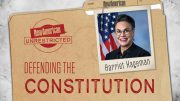
Every day, the power of the police (and their federal financiers) to track the movements of every American expands.
The latest loss of liberty involves the ability of license plate tracking software to recognize the faces of individual travelers in target vehicles.
A company called ElsaAG North America (a division of Finmeccanica, an Italian defense, aerospace, and security conglomerate) has developed automatic license plate readers (ALPR) and is aggressively marketing its high-tech trackers to U.S. law enforcement. Vigilant Solutions, another ALPR manufacturer, boasts of being a “trusted provider to tens of thousands of law enforcement professionals.” The Vigilant database reportedly “contains 2 billion entries,” with “70 million additional license plate photographs being added each month.”
Lest anyone doubt the scope and power of these tracking technologies, consider the following description of one of Vigilant’s latest products, the Mobile Companion:
Vigilant Solutions’ Mobile Companion is an industry-exclusive mobile app delivering the benefits of Vigilant’s Intelligence-Led Policing Package (including license plate recognition (LPR) and facial recognition technologies) to your mobile device.
The Mobile Companion is available to every officer with a mobile device and proper user permissions, as set by an Agency Manager. With the Mobile Companion, officers are now able to scan license plates, match against agency hotlists, query historical data, use the exclusive Mobile Hit Hunter feature to locate nearby hits generated by the Vigilant LPR network, and verify identities in the field using facial recognition. [Emphasis added.]
Simplicity is the selling point of this technology, according to information provided by Vigilant on its website.
“Plate capture is simple,” they boast.
“Mobile Companion’s interface is incredibly intuitive,” they claim.
And:
Facial Recognition is made incredibly simple and convenient on the Mobile Companion. Simply take a picture, or upload an image from a file or from social media, and match against the available gallery. Vigilant prepopulates the gallery with mugshot data, CrimeStopper data, and registered sex offender data. Agency Managers may upload additional images into their gallery (using the web interface) for better matching against local known individuals.
For your sake, I hope you don’t drive anywhere that suspected criminals frequent, because Vigilant’s Mobile Companion app empowers police to “query for possible associates of known criminals with just a few clicks of the mouse based on license plates frequently seen in close proximity to the subject.”
The Vigilant-developed facial recognition software supporting the expanded capabilities of the license plate trackers is known as FaceSearch. In order to lure new law enforcement customers, the power of the product is proudly proclaimed:
FaceSearch is an easy-to-use facial recognition solution that works. Available via the web, on mobile devices, and as a PC-based application, FaceSearch was developed by Vigilant to deliver a functional, scalable and affordable solution like no other. Hosted in the cloud, FaceSearch offers easy importing and integration capabilities, along with pre-populated face image data from Vigilant.
Over 350 facial vectoring algorithms are at the heart of Vigilant Solutions’ FaceSearch. Rather than making use of commercially available facial recognition engines, Vigilant leveraged its experience in image recognition to develop these new facial vectoring algorithms in-house. Why? — to benefit you in terms of accuracy, speed, and flexibility in deployment.
Then, lest any potential police department believe that this tool would be just too hard to use, Vigilant provides the following testimonial from a satisfied customer: “FaceSearch is the simplest interface I have seen for a facial recognition product. It has just the right amount of functionality without getting too technical or difficult.”
An article at theNewspaper.com announcing the marriage of license plate tracking and facial recognition technology advises that:
Though primarily intended for fixed security camera installations, the software could allow police to identify the occupants of vehicles when the system is supplied with a clear photograph of a car’s interior. In states such as California and Arizona where red light cameras and speed cameras photograph the front of a car, the video stream can be analyzed in “near real time” to catalog and identify the driver and anyone in the passenger seat of passing vehicles, flagging any “person of interest.”
This roll-out of mobile and fixed tracking tools raises questions about the proper job of law enforcement. More and more, it seems, police are being trained and equipped to behave like soldiers rather than peace officers. Rather than protecting and defending, cops are injuring and falsely accusing. All of this unfortunate transformation is aided by a federal government all too willing to give billions in grant money and used military equipment to local law enforcement agencies in exchange for additional federal-local “cooperation.”
Not to mention that the expansion of the surveillance state — as chronicled for years by The New American — is creating a country where there isn’t an unmonitored place in the real or cyber world. From Trapwire to Prism, from XKeyscore to the monitoring of snail mail, the federal government and the law enforcement that is regularly the beneficiary of its legal plunder of citizens are always watching us.
One picture of a car and its passengers, one unwarranted wiretap, one unwarranted seizure of a phone record, one search of records of an individual’s digital communications is too many. If we are a Republic of laws, then the supreme constitutional law of the land must be obeyed.
The standard is not whether the spies or their bosses think the deprivations are necessary. The standard is the Constitution — for every issue, on every occasion, with no exceptions. Anything less than that is a step toward tyranny.
Taken together, the surveillance and tracking programs in use by the federal government place every American under the threat of constant surveillance. The courts, Congress, and the president have formed an unholy alliance bent on obliterating the Constitution and establishing a country where every citizen is a suspect and is perpetually under the never-blinking eye of the government.
The establishment will likely continue construction of the surveillance apparatus until the entire country is being watched around the clock and every monitored activity is recorded and made retrievable by agents who will have a dossier on every American.
The fight can yet be won, though. Americans can attack the sprawling surveillance state on several fronts. First, we must elect men and women to federal office who will honor their oaths of office to preserve, protect, and defend the Constitution. Then, once in office, each of them must be held immediately accountable for each and every violation of that oath.
Next, we must fill our state legislatures with men and women who will refuse to enforce any act of the federal government that exceeds the boundaries of its constitutionally granted powers. These lawmakers must force the federal beast back inside its constitutional cage and never accept even a degree of deviation from the blueprint drawn in Philadelphia in 1787.
Though the hour is late, there is still hope. Beginning today, Americans can refuse to re-elect any local or federal lawmaker who has voted to fund any tool or technology that can be used to violate constitutional restraints. We can unite, as our forefathers, in the ennobling cause of the end of tyranny and the promotion of those unalienable rights granted to us — and revocable only — by our Creator.
Joe A. Wolverton, II, J.D. is a correspondent for The New American. Follow him on Twitter @TNAJoeWolverton.



